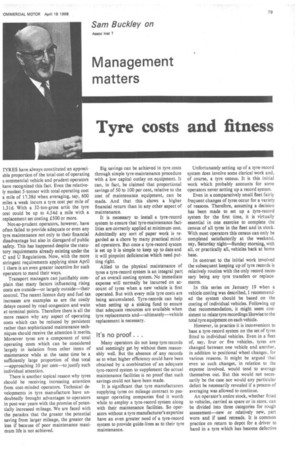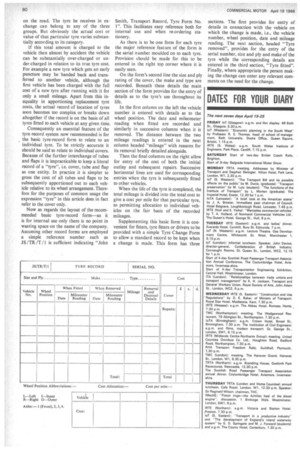Sam Buckley on
Page 81

Page 82

If you've noticed an error in this article please click here to report it so we can fix it.
Assoc Inst T
Management matters
Tyre costs and fitness
TYRES have always constituted an appreciable proportion of the total cost of operating a commercial vehicle and prudent operators have recognized this fact. Even the relatively modest 5-tonner with total operating cost a mile of 17.38d when averaging, say, 600 miles a week incurs a tyre cost per mile of 1.31d. With a 32-ton-gross artic the tyre cost could be up to 4.54d a mile with a replacement set costing £500 or more.
Not-so-prudent operators, however, have often failed to provide adequate or even any tyre maintenance not only to their financial disadvantage but also in disregard of public safety. This has happened despite the statutory requirements already existing under the C and U Regulations. Now, with the more stringent requirements applying since April 1 there is an even greater incentive for such operators to mend their ways.
Transport managers can justifiably complain that many factors influencing rising costs are outside—or largely outside—their control. The recent licence duty and fuel tax increases are examples as are the costly delays caused by road congestion and waits at terminal points. Therefore there is all the more reason why any aspect of operating costs which can be reduced by persistent rather than sophisticated maintenance techniques should receive the attention it merits. Moreover tyres are a component of total operating costs which can be considered largely in isolation from other items of maintenance while at the same time be a sufficiently large proportion of that total —approaching 10 per cent—to justify such individual attention.
There is another topical reason why tyres should be receiving increasing attention from cost-minded operators. Technical developments in tyre manufacture have undoubtedly brought advantages to operators in post-war years with the promise of potentially increased mileage. We are faced with the paradox that the greater the potential saving from larger mileage, the greater the loss if because of poor maintenance maximum life is not achieved. Big savings can be achieved in tyre costs through simple tyre-maintenance procedure with a low capital outlay on equipment. It can, in fact, be claimed that proportional savings of 50 to 100 per cent, relative to the cost of maintenance equipment, can be made. And that this shows a higher financial return than in any other aspect of maintenance.
It is necessary to install a tyre-record system to ensure that tyre-maintenance facilities are correctly applied at minimum cost. Admittedly any sort of paper work is regarded as a chore by many practical minded operators. But once a tyre-record system is set up it is simple to keep up to date and it will pinpoint deficiencies which need putting right.
Allied to the physical maintenance of tyres a tyre-record system is an integral par( of an overall costing system. No immediate expense will normally be incurred on account of tyres when a new vehicle is first operated. But with every mile tyre costs are being accumulated. Tyre-records can help when setting up a sinking fund to ensure that adequate resources are available when tyre replacements and—ultimately—vehicle replacement is necessary.
It's no proof. . .
Many operators do not keep tyre records and seemingly get by without them reasonably well. But the absence of any records as to what higher efficiency could have been obtained by a combination of an adequate tyre-record system to supplement the actual maintenance facilities is no proof that such savings could not have been made.
It is significant that tyre manufacturers supplying tyres on mileage contract to passenger operating companies find it worth while to employ a tyre-record system along with their maintenance facilities. So operators without a tyre manufacturer's expertise have an even greater need of a tyre-record system to provide guide-lines as to their tyre maintenance. Unfortunately setting up of a tyre-record system does involve some clerical work and, of course, a tyre census. It is this initial work which probably accounts for some operators never setting up a record system.
Even in a comparatively small fleet fairly frequent changes of tyres occur for a variety of reasons. Therefore, assuming a decision has been made to set up a tyre-record system for the first time, it is virtually essential in one exercise to complete the census of all tyres in the fleet and in stock. With most operators this census can only be completed satisfactorily at the weekend, say, Saturday night—Sunday morning, with all, or practically all, vehicles back at home base.
In contrast to the initial work involved the subsequent keeping up of tyre records is relatively routine with the only record necessary being any tyre transfers or replacements.
In this series on January 19 when a vehicle costing was described, I recommended the system should be based on the costing of individual vehicles. Following up that recommendation, it might seem consistent to relate tyre recordings likewise to the total tyre equipment on each vehicle.
However, in practice it is inconvenient to base a tyre-record system on the set of tyres fitted to individual vehicles. Even in a fleet of, say, four or five vehicles, tyres are changed between one vehicle and another, in addition to positional wheel changes, for various reasons. It might be argued that even so such changes, in relation to the expense involved, would tend to average themselves out. But this would not necessarily be the case nor would any particular defect be necessarily revealed if a process of averaging was allowed to continue.
An operator's entire stock, whether fitted to vehicles, carried as spare or in store. can be divided into three categories for rough assessment—new or relatively new, part worn and if used retreads. It is common practice on return to depot for a driver to hand in a tyre which has become defective on the road. The tyre he receives in exchange can belong to any of the three groups. But obviously the actual cost or value of that particular tyre varies substantially according to its category.
If this total amount is charged to the vehicle then almost by accident the vehicle can be substantially over-charged or under-charged in relation to its true tyre cost. For example a new tyre which gets an early puncture may be handed back and transferred to another vehicle, although the first vehicle has been charged with the full cost of a new tyre after running with it for only a small mileage. Apart from this inequality in apportioning replacement tyre costs, the actual record of location of tyres soon becomes too complex or breaks down altogether if the record is on the basis of all tyres fitted to each vehicle at any given time.
Consequently an essential feature of the tyre-record system now recommended is for the basic tyre-record form to relate to an individual tyre. To be strictly accurate it should be said to relate to individual covers. Because of the further interchange of tubes and flaps it is impracticable to keep a literal record of a "tyre", i.e. cover, tube and flap as one entity. In practice it is simpler to gross the cost of all tubes and flaps to be subsequently apportioned out to each vehicle relative to its wheel arrangement. Therefore for the purposes of common usage the expression "tyre" in this article does in fact refer to the cover only.
Now as regards the layout of the recommended basic tyre-record form—as it is for internal use only there is no point in wasting space on the name of the company. Assuming other record forms are employed a simple reference number such as JS /TR /T /1 is sufficient indicating "John Smith, Transport Record, Tyre Form No. I". This facilitates easy reference both for internal use and when re-ordering stationery.
As there is to be one form for each tyre the major reference feature of the form is the serial number moulded on to each tyre. Provision should be made for this to be entered in the right top corner where it is easily seen.
On the form's second line the size and ply rating of the cover, the make and type are recorded. Beneath these details the main section of the form provides for the entry of details as to the tyre's use throughout its life.
In the first column on the left the vehicle number is entered with details as to the wheel position. The date and mileometer reading when fitted are recorded and similarly in successive columns when it is removed. The distance between the two mileage readings is entered in the next column headed "mileage" with reasons for its removal briefly detailed alongside.
Then the final columns on the right allow for entry of the cost of both the initial outlay and subsequent repairs. Successive horizontal lines are used for corresponding entries when the tyre is subsequently fitted to other vehicles.
When the life of the tyre is completed, the total mileage is divided into the total cost to give a cost per mile for that particular tyre, so permitting allocation to individual vehicles on the fair basis of the recorded mileages.
Supplementing this basic form it is convenient for fitters, tyre fitters or drivers to be provided with a simple Tyre Change Form to allow a standard record to be kept when a change is made. This form has three sections. The first provides for entry of details in connection with the vehicle on which the change is made, i.e., the vehicle number, wheel position, date and mileage reading. The next section, headed "Tyre removed", provides for the entry of the serial number, size and ply and make of the tyre while the corresponding details are entered in the third section, "Tyre fitted". Finally, where appropriate the person making the change can enter any relevant comments on the need for the change.








































































































































